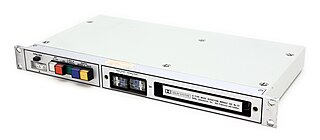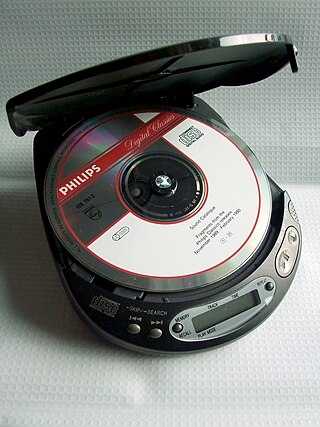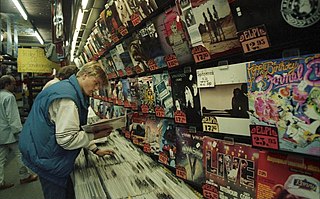
The compact disc (CD) is a digital optical disc data storage format that was codeveloped by Philips and Sony to store and play digital audio recordings. It uses the Compact Disc Digital Audio format which typically provides 74 minutes of audio on a disc. In later years, the compact disc was adapted for nonaudio computer data storage purposes as CD-ROM and its derivatives. First released in Japan in October 1982, the CD was the second optical disc technology to be invented, after the much larger LaserDisc (LD). By 2007, 200 billion CDs had been sold worldwide.

MiniDisc (MD) is an erasable magneto-optical disc-based data storage format offering a capacity of 60, 74, and later, 80 minutes of digitized audio.

The VHS is a standard for consumer-level analog video recording on tape cassettes, invented in 1976 by the Victor Company of Japan (JVC). It was the dominant home video format throughout the tape media period in the late 1970s, 1980s, 1990s, and early 2000s.

The Compact Cassette, also commonly called a cassette tape, audio cassette, or simply tape or cassette, is an analog magnetic tape recording format for audio recording and playback. Invented by Lou Ottens and his team at the Dutch company Philips, the Compact Cassette was released in August 1963.

Digital Audio Tape is a signal recording and playback medium developed by Sony and introduced in 1987. In appearance it is similar to a Compact Cassette, using 3.81 mm / 0.15" magnetic tape enclosed in a protective shell, but is roughly half the size at 73 mm × 54 mm × 10.5 mm. The recording is digital rather than analog. DAT can record at sampling rates equal to, as well as higher and lower than a CD at 16 bits quantization. If a comparable digital source is copied without returning to the analogue domain, then the DAT will produce an exact clone, unlike other digital media such as Digital Compact Cassette or non-Hi-MD MiniDisc, both of which use a lossy data-reduction system.

A Dolby noise-reduction system, or Dolby NR, is one of a series of noise reduction systems developed by Dolby Laboratories for use in analog audio tape recording. The first was Dolby A, a professional broadband noise reduction system for recording studios in 1965, but the best-known is Dolby B, a sliding band system for the consumer market, which helped make high fidelity practical on cassette tapes, which used a relatively noisy tape size and speed. It is common on high-fidelity stereo tape players and recorders to the present day, although Dolby has as of 2016 ceased licensing the technology for new cassette decks. Of the noise reduction systems, Dolby A and Dolby SR were developed for professional use. Dolby B, C, and S were designed for the consumer market. Aside from Dolby HX, all the Dolby variants work by companding: compressing the dynamic range of the sound during recording, and expanding it during playback.

The 8-track tape is a magnetic-tape sound recording technology that was popular from the mid-1960s to the early 1980s, when the compact cassette, which pre-dated the 8-track system, surpassed it in popularity for pre-recorded music.
A cassette deck is a type of tape machine for playing and recording audio cassettes that does not have a built-in power amplifier or speakers, and serves primarily as a transport. It can be a part of an automotive entertainment system, a part of a portable mini system or a part of a home component system. In the latter case it is also called a component cassette deck or just a component deck.

A CD player is an electronic device that plays audio compact discs, which are a digital optical disc data storage format. CD players were first sold to consumers in 1982. CDs typically contain recordings of audio material such as music or audiobooks. CD players may be part of home stereo systems, car audio systems, personal computers, or portable CD players such as CD boomboxes. Most CD players produce an output signal via a headphone jack or RCA jacks. To use a CD player in a home stereo system, the user connects an RCA cable from the RCA jacks to a hi-fi and loudspeakers for listening to music. To listen to music using a CD player with a headphone output jack, the user plugs headphones or earphones into the headphone jack.

A boombox is a transistorized portable music player featuring one or two cassette tape players/recorders and AM/FM radio, generally with a carrying handle. Beginning in the mid 1990s, a CD player was often included. Sound is delivered through an amplifier and two or more integrated loudspeakers. A boombox is a device typically capable of receiving radio stations and playing recorded music. Many models are also capable of recording onto cassette tapes from radio and other sources. In the 1990s, some boomboxes were available with MiniDisc recorders and players. Designed for portability, boomboxes can be powered by batteries as well as by line current. The boombox was introduced to the American market during the late 1970s. The desire for louder and heavier bass led to bigger and heavier boxes; by the 1980s, some boomboxes had reached the size of a suitcase. Some larger boomboxes even contained vertically mounted record turntables. Most boomboxes were battery-operated, leading to extremely heavy, bulky boxes.

Ampex Data Systems Corporation is an American electronics company founded in 1944 by Alexander M. Poniatoff as a spin-off of Dalmo-Victor. The name AMPEX is a portmanteau, created by its founder, which stands for Alexander M. Poniatoff Excellence. Ampex operates as Ampex Data Systems Corporation, a subsidiary of Delta Information Systems, and consists of two business units. The Silicon Valley unit, known internally as Ampex Data Systems (ADS), manufactures digital data storage systems capable of functioning in harsh environments. The Colorado Springs, Colorado, unit, referred to as Ampex Intelligent Systems (AIS), serves as a laboratory and hub for the company's line of industrial control systems, cyber security products and services and its artificial intelligence/machine learning technology.

The Digital Compact Cassette (DCC) is a magnetic tape sound recording format introduced by Philips and Matsushita Electric in late 1992 and marketed as the successor to the standard analog Compact Cassette. It was also a direct competitor to Sony's MiniDisc (MD), but neither format toppled the then-ubiquitous analog cassette despite their technical superiority, and DCC was discontinued in October 1996.

Reel-to-reel audio tape recording, also called open-reel recording, is magnetic tape audio recording in which the recording tape is spooled between reels. To prepare for use, the supply reel containing the tape is placed on a spindle or hub. The end of the tape is manually pulled from the reel, threaded through mechanical guides and over a tape head assembly, and attached by friction to the hub of the second, initially empty takeup reel. Reel-to-reel systems use tape that is 1⁄4, 1⁄2, 1, or 2 inches wide, which normally moves at 3+3⁄4, 7+1⁄2, 15 or 30 inches per second. Domestic consumer machines almost always used 1⁄4 inch (6.35 mm) or narrower tape and many offered slower speeds such as 1+7⁄8 inches per second (4.762 cm/s). All standard tape speeds are derived as a binary submultiple of 30 inches per second.

dbx is a family of noise reduction systems developed by the company of the same name. The most common implementations are dbx Type I and dbx Type II for analog tape recording and, less commonly, vinyl LPs. A separate implementation, known as dbx-TV, is part of the MTS system used to provide stereo sound to North American and certain other TV systems. The company, dbx, Inc., was also involved with Dynamic Noise Reduction (DNR) systems.

An album is a collection of audio recordings issued on a medium such as compact disc (CD), vinyl (record), audio tape, or digital. Albums of recorded sound were developed in the early 20th century as individual 78 rpm records collected in a bound book resembling a photo album; this format evolved after 1948 into single vinyl long-playing (LP) records played at 33+1⁄3 rpm.

U-matic or 3⁄4-inch Type E Helical Scan or SMPTE E is an analogue recording videocassette format first shown by Sony in prototype in October 1969, and introduced to the market in September 1971. It was among the first video formats to contain the videotape inside a cassette, as opposed to the various reel-to-reel or open-reel formats of the time. The videotape is 3⁄4 in (19 mm) wide, so the format is often known as "three-quarter-inch" or simply "three-quarter", compared to open reel videotape formats in use, such as 1 in (25 mm) type C videotape and 2 in (51 mm) quadruplex videotape.

Cheapo is a music retail chain with 3 locations in Minnesota where customers can purchase new and used compact discs, DVDs, and, at some locations, cassettes and vinyl records. The stores' trademark is a vast selection of new, used, and local music at competitive prices. While the stores generally focus on popular music of numerous types, the locations in St. Paul and Minneapolis also feature jazz and classical music. The Minnesota locations have "the world’s largest selection of Minnesota and North Dakota music." Used discs purchased by Cheapo first go into unsorted racks—one for each day of the week—before being sorted and placed into the general collection. There are usually a few listening stations for trying out discs. Stores may also feature an area of "top ten" selections for a regional radio station. Around 2004, ads called the company "the last authentic music store."

A record shop or record store is a retail outlet that sells recorded music. Per the name, in the late 19th century and the early 20th century, record shops only sold gramophone records. But over the course of the 20th century, record shops sold the new formats that were developed, such as eight track tapes, compact cassettes and compact discs (CDs). Today, in the 21st century, record stores mainly sell CDs, vinyl records and, in some cases, DVDs of movies, TV shows, cartoons and concerts. Some record stores also sell music-related items such as posters of bands or singers, related clothing items and even merchandise such as bags and coffee mugs.
Recorded music is a reflection of modern Indonesian history and culture—specifically class consciousness, economics and post-colonial identity. Since the early 1970s, the production, marketing and distribution of recorded media, particularly popular music cassettes and VCDs, in Indonesia have evolved in tandem with the archipelago's ongoing integration of tradition and modernity.
A digital copy is a commercially distributed computer file containing a media product such as a film or music album. The term contrasts this computer file with the physical copy with which the digital copy is usually offered as part of a bundle. It allows the disc's purchaser to acquire a single copy of the film on a digital device such as a personal computer, smartphone, tablet computer, or digital media player, and view it on those devices without requiring access to the physical media. "Digital copy" is also commonly referred to as "Digital HD".
















